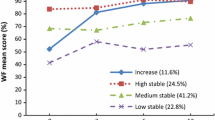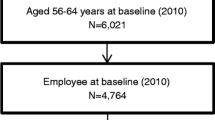Abstract
Introduction Work disability causes high costs for economy, organizations, and employees. However, medical rehabilitation does not always enable employees to return to their old jobs. In the present study, we investigated how disease classification and work characteristics interact in predicting the success of medical rehabilitation in terms of one’s ability to return to a former job. Methods To this end, we matched 2009 patient data from the German Statutory Pension Insurance agency with job characteristics data from the Occupational Information Network (O*NET) 17.0 database. We used a multilevel approach and a sample of N = 72,029, nested in 194 occupational groups. Results We found that workers are less likely to reenter a former job if mental illnesses coincide with emotionally demanding labor and if musculoskeletal diseases coincide with extreme environmental conditions. We did not find different effects between occupational groups for other types of diseases (circulatory system, neoplasms, injuries, others). Conclusion Thus, the contextual overlap of disease and occupational characteristics notably lowers the chances of a successful return-to-work. These findings should be taken into account by physicians when attempting to set realistic goals for rehabilitation in collaboration with the patient and the funding agency.



Similar content being viewed by others
References
Ensminger ME, Celentano DD. Unemployment and psychiatric distress: social resources and coping. Soc Sci Med. 1988;27(3):239–47.
Butterworth P, Gill SC, Rodgers B, Anstey KJ, Villamil E, Melzer D. Retirement and mental health: analysis of the Australian national survey of mental health and well-being. Soc Sci Med. 2006;62(5):1179–91.
Brockmann H, Müller R, Helmert U. Time to retire—time to die? A prospective cohort study of the effects of early retirement on long-term survival. Soc Sci Med. 2009;69(2):160–4.
Gjesdal S, Haug K, Ringdal P, Maeland JG, Hagberg J, Roraas T, et al. Sickness absence with musculoskeletal or mental diagnoses, transition into disability pension and all-cause mortality: a 9-year prospective cohort study. Scand J Public Health. 2009;37(4):387–94.
Federal Association of Company Health Insurance Funds [BKK Bundesverband]. Competetive advantage health: Costs of health related diseases in Germany [Wettbewerbsvorteil Gesundheit: Kosten arbeitsbedingter Erkrankungen in Deutschland]; 2008. http://www.dnbgf.de/fileadmin/texte/Downloads/uploads/dokumente/2008/BKK_Broschuere_arbeitsbedingteGesundheitskosten_RZ_web.pdf.
Henderson M, Glozier N, Holland Elliott K. Long term sickness absence. BMJ. 2005;330(7495):802–3.
Higgins A. The case for rehabilitation. Occup Health (Auckl). 2007;59(2):23–5.
Josephson M, Heijbel B, Voss M, Alfredsson L, Vingård E. Influence of self-reported work conditions and health on full, partial and no return to work after long-term sickness absence. Scand J Work Environ Health. 2008;34(6):430–7.
Vestling M, Tufvesson B, Iwarsson S. Indicators for return to work after stroke and the importance of work for subjective well-being and life satisfaction. J Rehabil Med. 2003;35(3):127–31.
German Statutory Pension Insurance (Deutsche Rentenversicherung). Reha-Bericht Update 2011: Die medizinische und berufliche Rehabilitation der Rentenversicherung im Licht der Statistik. [Medical and vocational rehabilition of the German Statutory Pension Insurance in the light of statistics.] 2011. http://www.deutsche-rentenversicherung.de.
Mittag O, Kolenda KD, Nordman KJ, Bernien J, Maurischat C. Return to work after myocardial infarction/coronary artery bypass grafting: patients’ and physicians’ initial viewpoints and outcome 12 months later. Soc Sci Med. 2001;52(9):1441–50.
Fang R, Duffy MK, Shaw JD. The Organizational Socialization Process: Review and Development of a Social Capital Model. J Manage. 2010;37(1):127–52.
Tomassen PC, Post MW, van Asbeck FW. Return to work after spinal cord injury. Spinal Cord. 2000;38(1):51–5.
Blank N, Diderichsen F. Short-term and long-term sick-leave in Sweden: relationships with social circumstances, working conditions and gender. Scand J Soc Med. 1995;23(4):265–72.
Ekberg K, Wildhagen I. Long-term sickness absence due to musculoskeletal disorders: the necessary intervention of work conditions. Scand J Rehabil Med. 1996;28(1):39–47.
Gomes J, Lloyd O, Norman N. The health of the workers in a rapidly developing country: effects of occupational exposure to noise and heat. Occup Med (Oxford, England). 2002;52(3):121–8.
Parkes KR. Shiftwork, job type, and the work environment as joint predictors of health-related outcomes. J Occup Health Psych. 1999;4(3):256–68.
Wickens CDHJ. Engineering psychology and human performance. Upper Saddle River: Prentice Hall; 1999.
Krause N, Lynch J, Kaplan GA, Cohen RD, Goldberg DE, Salonen JT. Predictors of disability retirement. Scand J Work Environ Health. 1997;23(6):403–13.
Ekberg K. Workplace changes in successful rehabilitation. J Occup Rehabil. 1995;5(4):253–69.
Krause N, Frank JW, Dasinger LK, Sullivan TJ, Sinclair SJ. Determinants of duration of disability and return-to-work after work-related injury and illness: challenges for future research. Am J Ind Med. 2001;40(4):464–84.
Siegert RJ, Taylor WJ. Theoretical aspects of goal-setting and motivation in rehabilitation. Disabil Rehabil. 2004;26(1):1–8.
Soderberg S, Jumisko E, Gard G. Clients’ experiences of a work rehabilitation process. Disabil Rehabil. 2004;26(7):419–24.
Muchinsky PM, Raines JM. The overgeneralized validity of validity generalization. J Organ Behav. 2013;34(7):1057–60.
Choi Y-H, Hu H, Tak S, Mukherjee B, Park SK. Occupational noise exposure assessment using O* NET and its application to a study of hearing loss in the US general population. Occup Environ Med. 2012;69(3):176–83.
Barnes AJ, Zimmerman FJ. Associations of occupational attributes and excessive drinking. Soc Sci Med. 2013;92:35–42.
Alterman T, Grosch J, Chen X, Chrislip D, Petersen M, Krieg E Jr, et al. Examining associations between job characteristics and health: linking data from the Occupational Information Network (O* NET) to two US national health surveys. J Occup Environ Med. 2008;50(12):1401–13.
Forstmeier S, Maercker A, Maier W, van den Bussche H, Riedel-Heller S, Kaduszkiewicz H, et al. Motivational reserve: motivation-related occupational abilities and risk of mild cognitive impairment and Alzheimer disease. Psychol Aging. 2012;27(2):353–63.
Fischer S, Wiemer A, Diedrich L, Moock J, Rossler W. Hell is other people? Gender and interactions with strangers in the workplace influence a person’s risk of depression. PLoS ONE. 2014;9(7):e103501.
Brzoska P, Voigtlander S, Spallek J, Razum O. Utilization and effectiveness of medical rehabilitation in foreign nationals residing in Germany. Eur J Epidemiol. 2010;25(9):651–60.
World Health Organization [WHO]. The ICD-10 Classification of Mental and Behavioural Disorders: Clinical Descriptions and Diagnostic Guidelines: World Health Organization; 1992.
Gogstad AC, Kjellman AM. Rehabilitation prognosis related to clinical and social factors in brain injured of different etiology. Soc Sci Med. 1976;10(6):283–8.
Tan V, Cheatle MD, Mackin S, Moberg PJ, Esterhai JL. Goal setting as a predictor of return to work in population of chronic musculoskeletal pain patients. Int J Neurosci. 1997;92(3–4):161–70.
Bloch FS, Prins R. Who returns to work & why? A six-country study on work incapacity & reintegration (Vol. 5): Transaction Publishers; 2001.
Cheadle A, Franklin G, Wolfhagen C, Savarino J, Liu PY, Salley C, et al. Factors influencing the duration of work-related disability: a population-based study of Washington State workers’ compensation. Am J Public Health. 1994;84(2):190–6.
Kemmlert K, Lundholm L. Factors influencing ergonomic conditions and employment rate after an occupational musculoskeletal injury. J Occup Rehabil. 1994;4(1):11–21.
Hochschild AR. The Managed Heart: Commercialization of Human Feeling. California: University of California Press; 1983.
Snijders TAB, Bosker RJ. Multilevel Analysis: An Introduction to Basic and Advanced Multilevel Modeling. Thousand Oaks: SAGE Publications; 2011.
Rodriguez G, Elo I. Intra-class correlation in random-effects models for binary data. Stata J. 2003;3(1):32–46.
Rosenthal R, Jacobson L. Pygmalion in the classroom. Urban Rev. 1968;3(1):16–20.
Benavides FG, Benach J, Moncada S. Working conditions and sickness absence: a complex relation. J Epidemiol Commun H. 2001;55(5):368.
Bonde JP, Rasmussen MS, Hjollund H, Svendsen SW, Kolstad HA, Jensen LD, et al. Occupational disorders and return to work: a randomized controlled study. J Rehabil Med. 2005;37(4):230–5.
Wiles R, Ashburn A, Payne S, Murphy C. Discharge from physiotherapy following stroke: the management of disappointment. Soc Sci Med. 2004;59(6):1263–73.
Chapin MH, Kewman DG. Factors affecting employment following spinal cord injury: a qualitative study. Rehabil Psychol. 2001;46(4):400.
Grahn BE, Borgquist LA, Ekdahl CS. Motivated patients are more cost-effectively rehabilitated. A two-year prospective controlled study of patients with prolonged musculoskeletal disorders diagnosed in primary care. Int J Technol Assess Health Care. 2000;16(3):849–63.
Author information
Authors and Affiliations
Corresponding author
Ethics declarations
Conflicts of interest
Anita Wiemer, Christina Mölders, Sebastian Fischer, Wolfram Kawohl, and Wulf Rössler declare that they have no conflict of interest.
Ethics Statement
For our manuscript we analyzed data that was collected for documentation purposes by the German Statutory Pension Insurance (GSPI). Due to the documentary nature of the data, we could not obtain informed consent of the patients analyzed. The Research Data Center of the GSPI (FDZ-RV) provides researchers with micro-sets from these data in form of Public Use Files or Scientific Use Files. The Research Data Center strictly protects patients’ privacy in terms of full data anonymization.
Electronic supplementary material
Below is the link to the electronic supplementary material.
Rights and permissions
About this article
Cite this article
Wiemer, A., Mölders, C., Fischer, S. et al. Effectiveness of Medical Rehabilitation on Return-to-Work Depends on the Interplay of Occupation Characteristics and Disease. J Occup Rehabil 27, 59–69 (2017). https://doi.org/10.1007/s10926-016-9632-7
Published:
Issue Date:
DOI: https://doi.org/10.1007/s10926-016-9632-7




